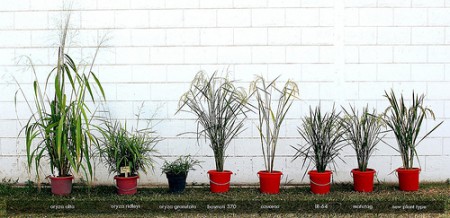- July issue of CSA News, official magazine for members of the American Society of Agronomy, Crop Science Society of America and Soil Science Society of America, has article on “Crop Adaptation to Climate Change” based on official CSSA position statement, “Crop Adaptation to Climate Change.”
- Factsheet on bacterial diversity and why it’s good for soils.
- FAO guidelines for the In Vivo Conservation of Animal Genetic Resources discussed in Europe.
- Please eat the daisies. Or other flowers.
- Farming chips.
- Never thought I’d get bored of reading about ancient beer.
Rice domestication roundup
In the past few weeks there’s been a number of papers on the genetics of rice domestication. I’ll just give you the main findings here, and leave you to battle with the details on your own. With the help of various other bloggers.
Dorian Fuller did a great job of summarizing the multiple domestication (or indica and japonica) theory at The Archaeobotanist a couple of weeks back. This seems to have the upper hand at the moment. Wild perennial rice is cultivated in wetland margins in the Neolithic Yangtze, and as the water ecology begins to be altered by humans, creating seasonal drought conditions to stimulate seed production, particular adaptations are selected (annuality, short stature, less branching etc.), which leads to the domestication of japonica rice. This is then taken to the area of an independently-domesticated proto-indica, probably around 3800-4000 years ago, and some genes are exchanged. So far, so good, and there is now a pretty comprehensive database of rice archaeology to back up the recent studies of single and multiple genes.
Well, certainly the “genetic and selective basis for domestication” seem to be different for japonica and indica, but another recent paper throws some doubt on the multiple domestication idea. Now, I’ve briefly discussed this with people who know a lot more about rice than I do and it seems the main sticking (as it were) point is the dating of the indica-japonica split to 3,900 years ago. Previous estimate were in the hundreds of thousands of years, supporting the multiple domestication theory, but the problem is that the newer, lower estimate was based on domestication genes only. Lots more argument on the horizon, I suspect.
Nibbles: Cryo, Tree diversity, Agroforestry, Seed industry, Trigonella, Ancient MesoAmerica, Niche models
- CIP’s high-tech genebank.
- “The project’s eventual aim is to plant several thousand trees at sites across Perthshire to act as a ‘living gene bank.'” What, because normally genebanks are dead?
- Millennium Seed Bank joins ICRAF’s BusyTrees thing. Which you can follow in about a million different social networking ways.
- Conservation Magazine does a number on crop improvement. Wait, what? Conservation Magazine? Yep, and with teaching resources.
- Fenugreek, barkeep, and make it a double.
- Ancient chocolate and corn routes.
- What species distribution models do you like?
Nibbles: Seed savers, Lemons, Assam Rice, Striga control, Amaranth, Bearded pigs, Banana, Early nutrition
- Seed savers: everyone’s got an angle, from Seeds of Hope and Change to Seed Bank Bingo.
- Italian lemons enjoying a renaissance. In California, natch.
- India registers Assam farmers’ traditional rice varieties. In other news, rice water “is also used as shampoo, according to community elders”.
- US$9 million to “implement and evaluate four approaches” to controlling Striga in Africa. One day we’ll know.
- Denver Botanic Gardens does amaranth.
- Evolution of bearded pigs. Good to know. Good to eat?
- Bioversity banana team guest blogs at Annals of Botany. But surely they have a blog of their own. No, wait…
- Agriculture is bad for your health.
Nibbles: Food security, Food carts, Cotton, Ritual, C4 C3 CC, American Indian diets, Community genebanks in India, Fowler, Dark earth soil, Domestication
- German donor examines food and security, notes “the fast loss of biodiversity”.
- Food carts are successful oases in at least one food “desert”.
- Yesterday’s Botany Photo of the Day was American cotton.
- Good news, everyone: “Hardcore farmers prefer lowkey rituals.” Obviously the memo didn’t reach the children of the corn.
- Photosynthesis and climate change: it’s complicated.
- Native Americans try to reclaim control of their foodways. And their waists.
- “…every district should have a community-controlled seed centre with a gene bank for traditional seeds.” Of course it should. “The local available seed diversity needs to be protected and conserved at any cost.” Of course it must.
- “Right now, all over the world, projects are underway to store seeds…“
- Dark earths not just in Amazon, Africa too.
- Presentation on IFAD project on cultivating wild aromatic etc. species for money in Morocco.
